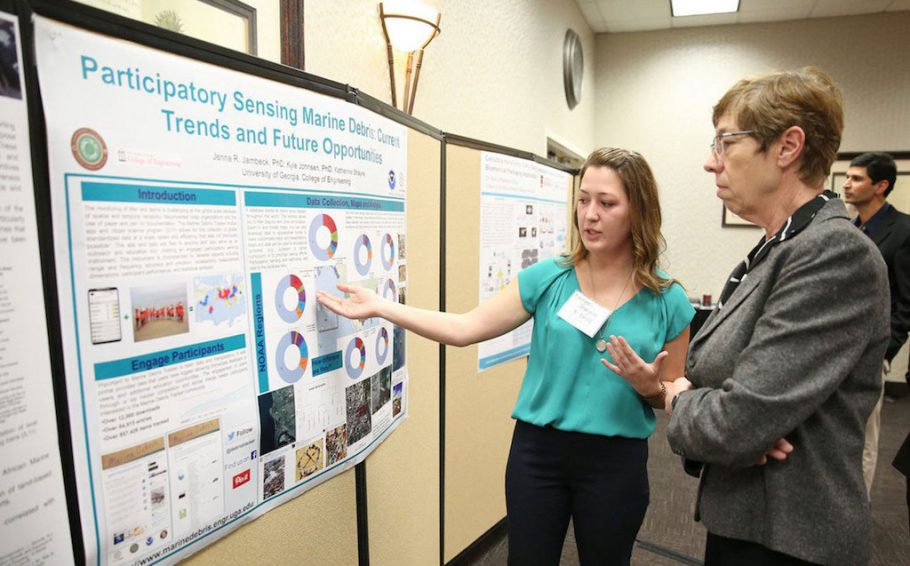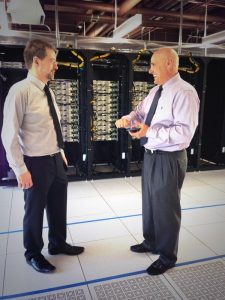
An absorbed faculty member in a university research lab could look up these days to find she’s working in a different landscape—a funding landscape, and it sure doesn’t look like it used to when faculty members relied almost solely on government funding for their research pursuits. Increasingly, faculty need to partner with industry to stay viable and to meet the demands of their own institutions and students, who want high-impact research experiences that will lead to jobs straight after graduation.
As we outlined in our article, industry-university partnerships deliver a wealth of financial and non-financial benefits to both parties, as well as drive innovation and economic growth. But forming these partnerships can be complex work. Even pursuing corporate partnerships isn’t what it used to be, and now more than ever faculty members have to take a proactive approach in an ultra-competitive funding arena.
Anthony Boccanfuso, president of the University-Industry Demonstration Partnership (UIDP), identified one party now clamoring for industry participation: the government. In 2012, UIDP published a handbook to help industry and universities work together more effectively.
“What has changed is that for most researchers who depend on federal money, there was never a stipulation, requirement, or incentive to work with companies,” he says. “Now many federal programs expect and require industry participation at some level—a strategy for engaging companies and bringing them to the table.”
Elizabeth Adams, assistant vice president for research administration at the University of Virginia, says faculty members need to manage their labs and departments like a business to diversify their funding streams.
“Faculty have to take hold of their own research program like a CEO,” she says. “Government money isn’t as certain as it used to be. From a pure budgetary standpoint, you have to make sure that you’ve got different funding sources coming in for your academic career and the careers of your students. There is a lot of pressure on universities to show the value they have to society. From the faculty perspective all the way up to the institutional perspective, you have this pressure to set the incentives that have people working with industry more.”
So, in this new landscape, how should faculty members forge industry partnerships? And once they’ve established partnerships, how can faculty members maximize these important relationships? Adams, Boccanfuso, and Heath Naquin, who leads strategic development at VentureWell, have a short list of best practices and strategies to help faculty work constructively with companies.
Four Ways to Engage Companies in Industry-University Collaborations
Working with industry gives faculty members and students an exciting opportunity to see their research have real-world impact. At the same time, this shifting landscape requires faculty members to take a proactive approach to funding rather than waiting for RFPs and allowing federal agencies to dictate their research agendas. Now, faculty members have to court industry partners and make a strong case for collaboration.
Proceed with Introspection
Before faculty members make a slapdash decision to sidle up to companies, Boccanfuso has some critical advice: ask yourself if you really want to do that. Partnering with companies has both benefits and challenges, and Boccanfuso says it’s “really important that you have an honest conversation with yourself about how you’re willing to work with engaged companies.”

For example, are you willing to work on a project that isn’t intellectually stimulating or scholarly, but provides a specialized piece of equipment to a manufacturing partner? Are you willing to let your PhD students spend six months on an internship at a company if it will grow the relationship? Are you willing to consult with a company on your own time, outside of the university structure?
“There are some faculty members that will support all of these examples, and others that will not. Do some internal processing about what it means to work with companies,” Boccanfuso says, who wrote about why industry-university partnerships matter for Science Translational Medicine.
Adams suggests that faculty members understand the difference between working with industry and undertaking hypothesis-driven work with government funding. “When you get funding from industry, there are different pressures on timeline and specifications,” she says. “A lot of faculty have government money where it’s possible to extend the timeline. Industry funding is a totally different thing. There’s a different culture to it.”
After some introspection, Boccanfuso says you have to gauge your university’s comfort level with working with companies. “It’s also really important to look at your institutional culture when it comes to working with corporations,” he says. “Most universities have policies and procedures, but they also have a lot of unwritten rules and strategies on how to work with industry. There’s no point in having a conversation with the company and going down a pathway only to realize that within your own institution that approach may or may not work.”
Listen, Don’t Just Gab
Faculty members are often exceedingly passionate about a narrow focus, but that doesn’t mean industry partners are as excited as you about the bells and whistles of your app, for example. In early meetings with companies, Boccanfuso and Naquin suggest leaving your diatribes and dissertations by the door.
“A faculty member will meet with a company representative and she will spend 45 minutes talking about all the intricacies of what she does in a research group,” Boccanfuso says. “The company may not be interested in that. They may have a different set of interests and criteria. I think a common challenge with faculty members when they work with or engage companies is they don’t do enough listening to uncover a company’s needs to see if they can meet them.”
Naquin urges faculty members to avoid selling industry on their big idea because “that almost always goes wrong. Find companies that are working in your field of interest and then ask them what they need and would like to work on first. Figuring out a way to provide value is a great first step. That’s how you can start the relationship.”
Engage Across Campus
Connecting with companies doesn’t have to be a lone venture for faculty members. In fact, many universities now have positions dedicated to fostering relationships with industry partners and can help guide faculty through the process.

“Sometimes faculty don’t realize how many resources they have at their disposal,” Adams says. “Deans, corporate engagements, corporate relations staff, tech transfer officers. Do those coffee meetings, get to know them, make sure that you’re on their map. There are a lot of resources at an institution to help the faculty market what they’re doing and get the word out.”
Boccanfuso recognizes that not every strategy he’s offering is transferable – every sector is different. Yet he suggests that faculty members simply talk with each other about their corporate partnership experiences. “It’s important to speak with colleagues that you respect in their discipline who have had experiences, positive or even negative, to find out what the benefits and challenges are.”
Check the Weather
The last thing a faculty member wants to do is pitch a partnership to a company in distress. Naquin says it’s important to look at trends across an industry to gauge the health and vitality of a company before approaching them.
“For example, in 2008, the solar industry crumbled from a few hundred companies in the U.S. to about 80, that was not a good time to try and approach people for industry collaboration,” Naquin says. “They were in survival mode. Being aware of whether an industry is in crisis mode or not is important. If they are laying people off, the odds of you getting an industry collaboration going are not high.”
Naquin also suggests additional homework: check Wall Street. Look at stock prices in your industry and read up on investments in the field. “If you’re seeing private investment into sectors you’re working in, that’s an indicator that the sector is doing well.”
Maximizing Relationships with Industry Partners
Forming industry partnerships is one thing; nurturing them for the long haul takes additional skill. Companies want to build trust with faculty members, and Boccanfuso says faculty members should shift from “transactional” relationships with companies to “strategic” ones, which requires persistent, holistic engagement.
“Faculty members have deep relationships with companies because they support them along the continuum of engagement, not just in the sponsored research,” he says. For example, faculty members might use their resources to bolster the company’s other pursuits at the university, like introducing a capstone project to the communications school or hosting a company’s foreign delegation on campus. “You want to be seen as a resource.”

Adams says faculty members are also deepening their relationships through sabbaticals to work at companies. “More and more, universities are making a commitment to you being connected to industry by supporting those kind of sabbaticals.”
For Naquin, maximizing industry partnerships boils down to customer service, relationship management, and transparent communication. “A faculty member might get industry funding but treat it like a federal grant versus a business activity, which is what it is for industry partners. You can’t really just disappear and say, ‘I’ll give you my findings in a paper.’ It needs to be collaborative and with regular interaction. Keep the thing alive. Interaction with industry is very different compared to what you might be used to from federal agencies.”
Meeting in person, says Adams, is also crucial to developing strong and lasting partnerships. “There’s no substitute for face-to-face time,” she says. “It’s not out of the question to go visit a company after you’ve gotten a few conversations under your belt. Show them your commitment.”
In the end, it’s really all about making connections with people. “It’s not companies and universities that make great relationships; it’s the people at companies and the people at universities,” Boccanfuso says. “If you have a strong industry-university partnership, there has to be a strong relationship between people.”
Faculty members have a lot on their plates to track down the funds required to manage their enterprises, which includes money that supports graduate students, post doc travel, equipment—the list goes on. Industry collaborations can directly and indirectly provide these needed resources, but faculty members have to be ready to embark on these partnerships and strike a balance between corporate relations and personal pursuits. The sky’s the limit in what industry and universities can achieve together, but first faculty members have to start on the ground—in the trenches—as they build and strengthen these relationships.
The National Science Foundation Industry-University Cooperative Research Centers (IUCRC) program catalyzes the impact of university research through partnerships with industry that can drive innovation and bolster the U.S. economy. Read more about the IUCRC program here, and learn more about the role VentureWell plays in the program here.
Read other articles about industry-university collaborations
Industry and University Collaboration: How Partnership Drives Innovation
Entrepreneurial Mindset: The Secret Ingredient to Successful Industry-University Partnerships